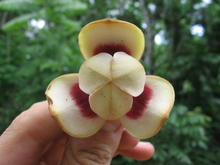Check out the websites blog for the lastest news from the field and for the website.
Click here for a key to the genera of Annonaceae

Annonaceae (www.annonaceae.org) is a tropical family of trees , shrubs, and lianas belonging to the order Magnoliales (APGII, 2003). It is the most diverse family of this early diverging plant order, comprising 108 genera and ca. 2500 species (Chatrou et al., 2012). They form an easily recognizable and natural group with alternate distichous leaves, a trimerous perianth, numerous stamens and one to numerous carpels (Keßler, 1993). Classification within the family and delimitation of genera, however, has been much debated (Koek-Noorman et al., 1990). Annonaceae are almost entirely tropical, with three main centers of distribution. The combined area of South-East Asia, Australia, and the Pacific islands is the richest in genera (ca. 60) and species (ca. 1100; (Keßler, 1993). Recent mophological and molecular phylogeneic studies have lead to a new classification of the family (Chatrou et al. 2012). In terms of genera, tropical Africa and the Neotropics are equivalent (ca. 40), but the latter holds more species, ca. 800 compared to ca. 500 respectively (Mols, 2004). A single genus occurs in North America: Asimina (which inlcudes the previously recognized genus Deeringothamus). Due to their pantropical distribution, great morphological diversity, and key ecological role in tropical forests (Gentry, 1993), systematic and evolutionary studies of Annonaceae taxa provide important insights into the evolution of tropical floras (e.g. Pirie et al., 2006; Erkens et al., 2007, Couvreur et al. 2008, 2011, Chatrou et al. 2010).
In this scratchpad we detail all genera naturally occurring across Africa, including Madagascar. Naturalized species such as Cananga odorata or Annona muricata are not treated. Moreover, in this new version of sratchpad I have opted for a phylogenetic classification of the genera, based on the new infra familial classification of Annonaceae (Chatrou et al. 2012). All sub families are represented in Africa except for Anaxagoreoideae. The menu starts with the first subfamily, Ambavioideae with 4 genera followed by Annonoideae containing the majority of genera, and finally Malmeoideae with 7 genera. Within these subfamilies, genera are organized alphabetically for ease if use at this stage. However, this might change.
African Annonaceaeare are overall very diverse, especially in there floral morphology. Several genera show unique floral characters. The most striking one is the occurrence of syncarpous flowers in Isolona and Monodora (Deroin, 1997, Couvreur et al. 2008, Couvreur, 2009). Other genera show interesting variations in the number of petal whorls, number of petals, fusing of petals, structure of the petals, shape of fruits, etc.
The African genera were treated as a whole for the last time over 100 years ago by Engler and Diels (1901). Since then, regional accounts have been published in the second half of the last century such as those for Flore du Gabon (Le Thomas, 1969) and Flora of Tropical East Africa (Verdcourt, 1971). Besides that, small proportions of African species have been part of monographic research (e.g. Chatrou, 1998; Maas et al., 2003). In more recent years a series of revisions and monographs have been published (Versteegh and Sosef, 2005, Couvreur et al. 2009, Botermans et al. 2011) .
The state of our taxonomic knowledge of African Annonaceae remains rather poor, but has been improving over the years. The goal of this web site is to provide a platform to share and disseminate taxonomical data as it becomes available.
Distribution
Most African Annonaceae are restricted to lowland or montane rain forests across Africa and in Madagascar. A minority of species, however, have adapted to slightly more arid conditions and can be found in thickets or savanna type vegetations.
Even though rain forests appear homogeneous across tropical Africa, species composition varies greatly between different regions. In Africa, the most striking difference is that between the Eastern Arc Mountains and Coastal rain forests of East Africa and the larger rain forest block in West-Central Africa called the Guineo-Congolian floristic region (White, 1979). Numerous studies have shown that even though both areas present strong botanical affinities, very few species co-occur in both East and West-Central Africa, i.e. the distribution of genera is often disjunct (Wasser and Lovett, 1993; Burgess et al., 1998; Burgess and Clarke, 2000). This disjunction is also very clear in Annonaceae, with almost no overlap between the two regions in terms of species distribution (Couvreur et al., 2006). However, many of these endemic species belong to genera that do co-occur in both areas, suggesting some kind of common history between the two areas.
Although we shall provide detailed descriptions of species, we will not go into nomenclature details (at least not now). We still want past publications to retain thier value!
For relevant information about publication of original descriptions etc, please check out Annonbase which provides a Global taxonomic / nomenclatural index for the whole family.
Also check out JSTOR Plant Science for images of African Annonaceae types and much more.

//
